Phelps, William (McKechnie Section 7)
See also Sections Two, Three and Four
Recorded by Mills. A silhouette had previously been illustrated by Jackson (The History of Silhouettes), who, however, had not by then discovered the artist's identity.
Phelps's one known trade label gives the address at Mr. Wilson's, Watchmaker, Drury Lane, opposite Long Acre, London.' Directory entries reveal that the watchmaker's full name was Alexander Wilson and that he lived on the eastern side of Drury Lane. The first entry (1783) lists him at No. 132, about half-way up the street; later entries (from 1785) list him at No. 152. The latest entry giving the latter address appeared in 1796. F. J. Britten (Old Clocks and Watches and Their Makers, 8th ed., ed. Cecil Clutton, London, 1973), tells us that Wilson was a member of the Watchmakers' Company 1781-94. Since he probably did not set up in business before his admission to the Company, it may have been in 1781 that he first occupied the premises at 132 Drury Lane. It must have been in 1784 that he moved to No. 152, since this address is first given in a directory entry for 1785.
I have illustrated some silhouettes, obviously by Phelps, which (judging by the sitters' costume) date from c. 1784. These bear no trade labels. Later (labelled) examples which I have examined date from January 1786 to November 1788 (Phelps left a space on his trade label for the date to be inserted). We therefore know that Phelps did work at 'Mr. Wilson's' between these dates, presumably at 152 Drury Lane. Later silhouettes of which I know, dated 1789, 1790 and 1791, do not bear this label but are signed and dated by hand; by 1789 Phelps may have left Wilson's premises. The silhouettes painted (apparently) in 1791 are the latest known dated pieces by Phelps; possibly he abandoned silhouette work after John Miers had established his studio at 111 Strand. It is a point of interest that Phelps, like Thomas Patey, was painting silhouettes on plaster before Miers arrived in London.
Silhouettes by Phelps are of two types: (1) those which he painted directly on to the plaster; (2) silhouettes which he painted initially on laid, thick buff paper, which he then stuck on to the plaster, adding a small amount of matching colour around the cut edges. His silhouettes, especially examples of type (1), are rare, and his style highly individual (see the two enlarged details). Few artists of his period were producing work of type (2), and his concealment of the cut edges round the profile in examples of this type is far more skilful, and far less obvious in execution, than that of most of the nineteenth-century artists who were to imitate his style.
It has been said by previous writers that a special feature of Phelps's work is his practice of adding touches of apple-green, mauve, pink or other colours to the dresses of his female sitters. Among the young women of the period, however, it was fashionable to wear dresses which were white, with touches of colour, and I think that Phelps (one of the few silhouette artists of the 1780s and 1790s who painted his sitters' costume in colour) was simply representing this fashion in a faithful manner. Equally fashionable were coloured sashes (matching ribbons in the hair or on the hat); these are shown on Phelps's work, as they are on miniatures of the time. Older women might not wear the fashionable colours; one illustrated silhouette represents an older woman who is wearing a dark-blue dress, with a white dormeuse cap and a frilled buffon.
1624
One characteristic of Phelps, in his work of type (2), is the way in which he shows the handkerchief worn by women across the bosom, or a man's shirt-frill, in buff, by means of the buff-coloured card which he used for such silhouettes.
Jackson records a silhouette of an officer, with the uniform in colour. The sight measurement was 3½ x 2⅜ in., and the silhouette was inscribed on the reverse, 'Taken by W. Phelps, 1790'. Neither this, nor any silhouette of a soldier which may come to light, should be confused with (for example) work by the Buncombes, who painted on card, not on plaster.
Not all Phelps's profiles are finished with a bust-line truncation; this, when seen, is of the normal concavity-convexity type. Coloured examples which may be discovered might show the double-loop concavity seen on some of Phelps's work in plain black.
On silhouettes of type (1), Phelps painted his sitters' hair in long, rather fine strokes of black; on some examples of type (2), however, he painted hair in its natural colour. There is much variation in his painting of the eyelash on both types of work.
Phelps used oval hammered brass frames, either with an acanthus or a beaded edge. No silhouette by him has been seen in the pearwood frame which became popular
c. 1790.
Two silhouettes of type (2) which I have seen, in private possession, painted largely in shades of reddish-brown and representing a brother and sister, Rowland and Anne Ramsden, are of especial interest in that the drawing on each appears to have been executed entirely with a quill. The sitters' names are written, with the dates (April 1786 on the profile of Anne Ramsden, June 1786 on that of her brother), in a contemporary hand on the brown paper (which probably conceals trade labels) with which the backs of the frames are sealed.
One printed trade label (illustrated) is known; it may have been used only 1786-88:
W. PHELPS MINIATURE PROFILE PAINTER at Mr. Wilson's Watch-Maker, Drury Lane opposite Long Acre, LONDON
Takes the most exact likenesses, either upon Glass, or a Composition perfectly WHITE which will keep its Colour. N.B. He preserves the original shades, and can supply those he has once taken with any number of duplicates.
Those who have shades in their possession, may have them copied, the likeness preserved, and dressed in the present taste, by applying to above. This Shade was taken on
Handwritten inscriptions are in a sprawling, cursive hand. One silhouette (of a sitter with the face in black and the costume in colour), sold by Sotheby and Company, London, on 26 April 1971, was inscribed: 'taken by/ W. Phelps/1789.' Another silhouette (of a woman, painted entirely in black on plaster), sold by the same auction house on 29 November 1971, was inscribed: 'By W. Phelps/Jan 7 1791.' I have already mentioned a silhouette, recorded by Jackson, bearing a similar inscription, including the date (1790). One of the illustrated silhouettes, dated by Mills to 1791, also probably bore an inscription of this type.
1619
Ills. 1617-1627
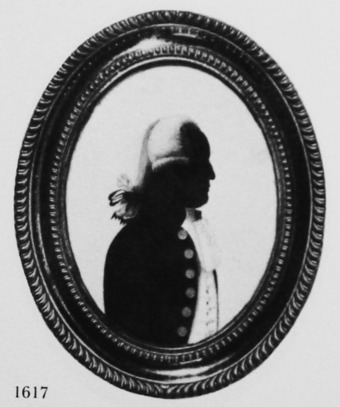
Thomas Wicksted, of Wigland, Cheshire
Silhouette painted on plaster, with the face in black and the costume in colour
? c. 1784
3 ¾ x 2 3/8 in./96 x 61mm.
Frame: oval, hammered brass
P. G. Higgs collection
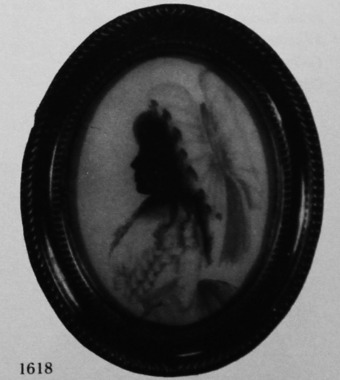
Unknown woman
Silhouette painted on plaster, with the face in black and the costume in colour
June 1788
3 ½ x 2 ¾ in./90 x 70mm.
Trade Label
Frame: oval, hammered brass
The date is inscribed on the trade label.
Author’s collection
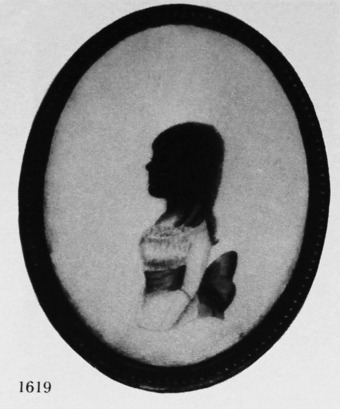
Miss Mostyn
Silhouette painted on plaster: the sitter’s face and hair in black; the costume in white, with detail in colour
1791
3 ½ x 2 5/8 in./90 x 67mm.
The sitter’s hair is painted in a style similar to that shown in 1618.
From Weymer Mills, ‘One Hundred silhouettes from the Wellesley Collection’ (1912), by courtesy of the Oxford University Press
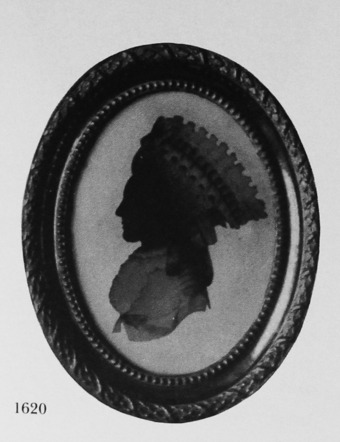
Unknown woman
Silhouette painted on buff paper (stuck to plaster), with the sitter’s face in black and the costume in colour
? 1784
3 ¾ x 2 ¾ in./96 x 70mm.
Frame: oval, hammered brass
This silhouette is unlabelled and undated; the date is suggested by the sitter’s extravagant dormouse cap and ‘banging chignon’.
Mrs Jean de Peyer collection
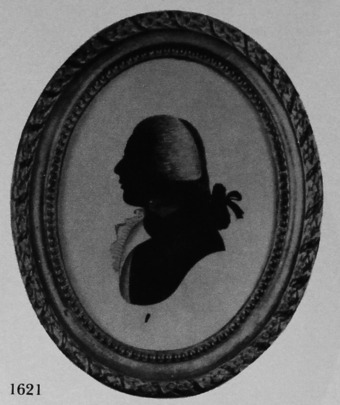
Unknown man
Silhouette painted on buff paper (stuck to plaster), with the sitter’s face in black and the costume in colour
c. 1784
3 ¾ x 2 ¾ in./96 x 70mm.
Frame: oval, hammered brass
M. A. H. Christie collection
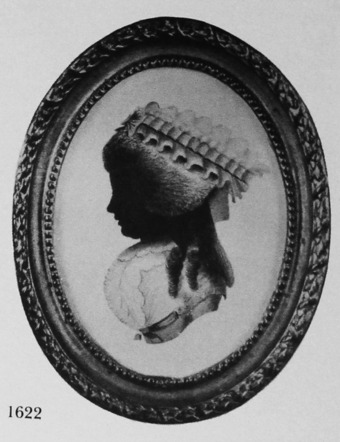
Unknown woman
Silhouette painted on buff paper (stuck to plaster), with the sitter’s face in black and the costume in colour
c. 1784
3 ¾ x 2 ¾ in./96 x 70mm.
Frame: oval, hammered brass
M. A. H. Christie collection
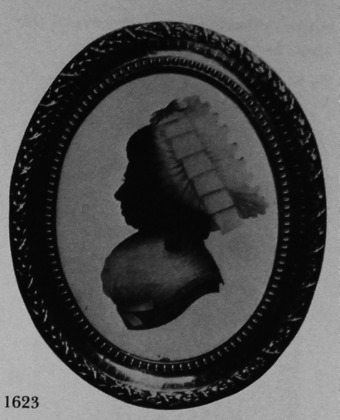
Mrs Twigge
Silhouette painted on buff paper (stuck to plaster), with the sitter’s face in black and the costume in colour
January 1786
3 ¾ x 2 ¾ in./96 x 70mm.
Trade label
Frame: oval, hammered brass
J. A. Pollak collection
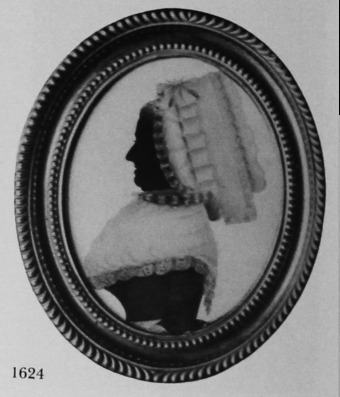
Unknown woman
Silhouette painted on buff paper (stuck to plaster), with the sitter’s face in black and the costume in colour
1787
3 ½ x 2 ¾ in./90 x 70mm.
Trade label
Frame: oval, hammered brass
The date is inscribed on the trade label.
T. E. F. Sainsbury collection
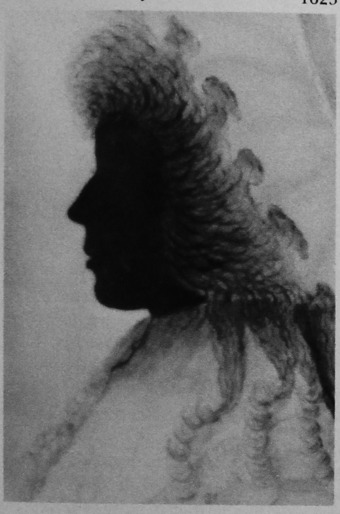
Detail from a silhouette (1618) by W. Phelps painted on plaster, photographed in magnification to show the style of the brushwork.
Author’s collection
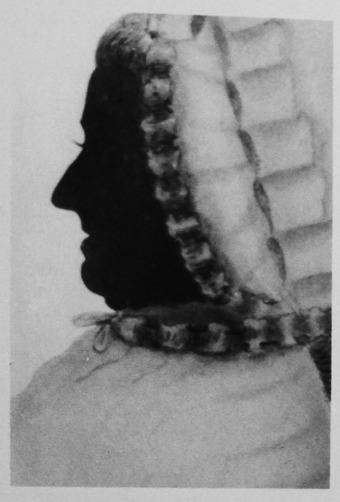
Detail from a silhouette (1624) by W. Phelps painted on buff card, stuck to plaster, photographed in magnification to show the style of the brushwork.
T. E. F. Sainsbury collection
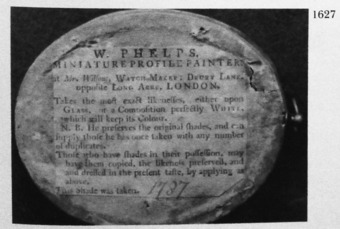
Trade label of W. Phelps, from the silhouette illustrated in 1624.
T. E. F. Sainsbury collection
